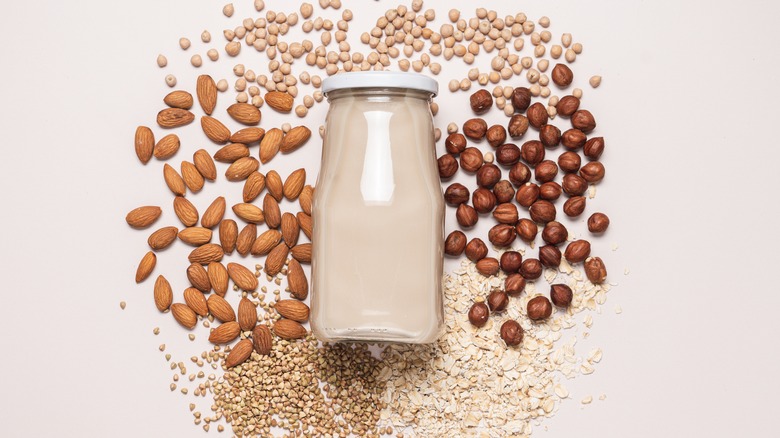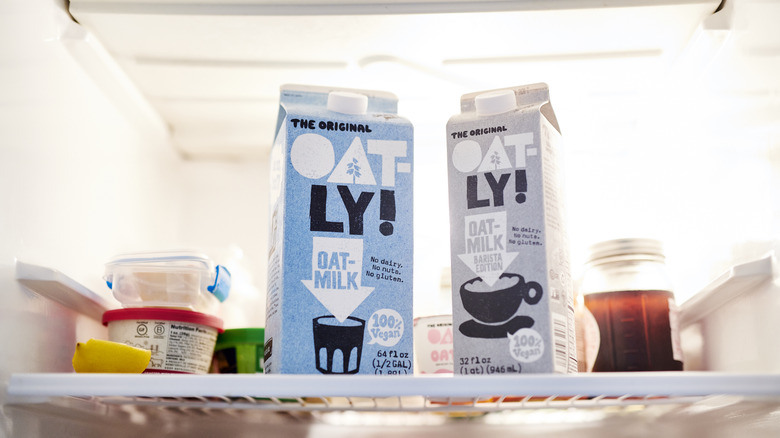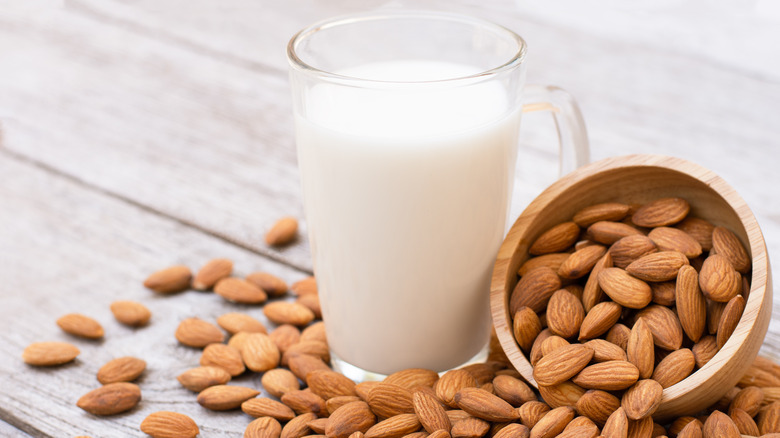What's The Nutritional Difference Between Oat Milk And Almond Milk?
There are many reasons consumers choose alternative dairy products — and a growing list of options on the market today. Dietary preferences, lactose intolerance, allergies, and concerns about sustainability and animal welfare may be among the factors driving the decline of fluid cow's milk consumption, which has decreased since 2010 (per the United States Department of Agriculture). Good Food Institute reports that in 2021, plant-based milk varieties were used by 42% of US households in some capacity.
Today's alternative dairy products are made from plants, including soy, rice, coconut, cashew, sunflower, sesame, hemp, oat, and almond milk. Yet almond milk and oat milk remain the most popular choices (per CNBC). The professional culinary world is embracing dairy-free milk, too: In 2021, enthusiastic meat eater Gordon Ramsay helped promote Silk's brand alongside other celebrities, and private chef Brooke "Chef Bae" Baevsky likes using almond milk in her recipes. While oat and almond milk appear alike and are used similarly, there are some critical differences between them in terms of ingredients, nutrition, and more.
Oat milk in profile
Oat milk is made with the grains of a cereal grass (per Britannica) that USA Today explains are processed, mixed with water, and strained. CNBC reports that commercial oat milk was invented in 1994 by Swedish brothers Rickard and Bjorn Oeste, whose company — Oatly — is endorsed by the likes of Starbucks and Oprah Winfrey. According to Healthline, oat milk froths well and is often sold as coffee creamer, as it tends to be thicker and sweeter than almond milk. Martha Stewart supports oat milk in beverages, breakfast, baking, and beyond.
Oat milk has more protein, fat, and fiber than almond milk. But oat milk also tends to have more calories and carbohydrates than almond milk, making it less suitable for calorie-controlled and low-carb diets (per Good Housekeeping). With the word oat milk added to the dictionary in 2022, we'll clearly continue to see exciting new oat milk products on store shelves.
Aww, nuts: dairy-free downsides
Almond milk dates back to the 14th century (per Merriam-Webster). It's made from ground almonds (a tree nut) and water. Almond milk tastes somewhat nutty and is not as rich as oat milk — making it better for smoothies and non-dessert dishes, per Healthline. It has fewer calories and carbs than oat milk, with high amounts of beneficial unsaturated fats and antioxidant vitamin E, according to Good Housekeeping. To improve almond milk's texture, additional ingredients may be added and fortified (per Eating Well).
But almond milk comes with a deeper carbon footprint than oat milk, as almonds are water-intensive crops. California, which often experiences drought conditions, produces 80% of the world's supply of almonds (per the Almond Board of California). Overall, Healthline reminds us that oat milk and almond milk have less protein than cow's milk and must be fortified to compensate for their absence of the vitamins and minerals of conventional dairy milk. They also warn consumers about added sugar in milk substitutes and potentially problematic plant-based additives like guar gum and carrageenan. You can always make oat and almond milk at home to control what goes into them and put them to use in simple recipes like oat milk honey lattes or date and honey almond milk. You can also utilize these plant-based pantry staples in your everyday cooking.


